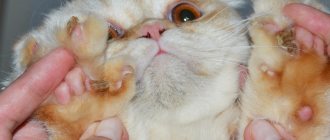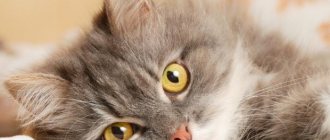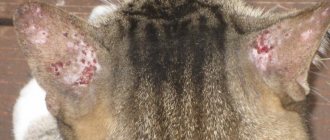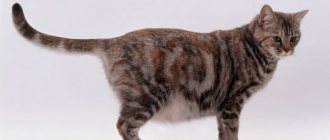A cat's lip ulcer may be caused by Jacobs disease. The disease is similar to herpes rashes on the human lip. More often, the disease affects cats that have reduced immunity.
Also, purebred cats, especially the British breed, are more often susceptible to the disease. Jacobs disease is manifested by defects in the skin, most often an ulcer on the upper or lower lip, but with extensive damage, defects in the integrity of the mucous membrane of the cheeks and abdominal skin are possible.
The cat has a sore on her lip: Is there viral rhinotracheitis on her face?
Viral rhinotracheitis - herpes in cats, like other viral respiratory infections, is widespread. The disease affects everyone from the cat family; all breeds of cats are affected, regardless of age, with the exception of kittens up to two months of age, which receive antibodies from their mother with milk.
Risk factors for infection:
- Group keeping of animals (shelters, catteries)
- Animals weakened by stress.
- Inadequate feeding.
- Ages from two months to one year and over fourteen years.
The peak of the disease in cats occurs during the cold and rainy seasons (winter, early spring, late autumn). When kept in crowded conditions, the infection takes on the character of a permanent enzootic.
Watch the video: Sore on a cat’s lip - on the face Calicivirus
The source of feline rhinotracheitis are patients and carrier cats. The rhinotracheitis virus can be transmitted to healthy cats through direct contact with sick animals through discharge from the nasal and oral cavity and eyes.
The main route of infection is aerogenic, that is, through the air, which contributes to the rapid spread of the disease.
The most common routes of transmission are food, care items, people in contact with sick cats, and contaminated air. The disease is species-specific and is not dangerous for humans or other animal species.
If the cause of sores on a cat’s lips is viral rhinotracheitis, the clinical picture will be as follows:
- Copious nasal discharge.
- Decreased appetite.
- Lethargy.
- Fever.
- Cough.
- Ulcers on the lips that look like herpetic rashes in humans.
- Increased lacrimation, conjunctivitis.
The course of the disease can be acute, subacute and chronic; in advanced cases, severe pneumonia develops.
Read the article “How to give medicine to a cat?
Tips for ensuring comfort for a cat" - https://strazhchistoty.ru/cleanup/cleancats/kak-dat-lekarstvo-koshke.html
Rhinotracheitis: symptoms and treatment
This disease is quite dangerous and is compared to the herpes virus in humans. Based on its symptoms, it is often confused with a common cold. Redness on the lips is just one of the signals that the cat is sick. Rhinotracheitis is accompanied by:
- runny nose and profuse nasal discharge;
- lacrimation;
- cough;
- decreased appetite;
- increased body temperature;
- drowsiness.
If the cat is not treated, the FHV-1 virus (it is the cause of rhinotracheitis) gives complications in the form of pneumonia or chronic diseases of the digestive system. Externally, the advanced disease is manifested by the appearance of ulcers on the cornea of the eyes and tongue, the occurrence of convulsions of the limbs, and impaired coordination of movements. At the same time, death occurs in only 15% of animals with herpes.
With rhinotracheitis, a wound on the lip causes anxiety for the cat. It itches constantly, which is why the red spot quickly grows and the skin underneath bursts. In this case, there is a risk of secondary infection with a bacterial or fungal infection.
It will not be possible to completely get rid of the virus; the cat will forever remain its carrier. Treatment should begin as soon as a red spot appears on the cat's lip. For this, conventional “human” drugs are used, for example, Acyclovir at the rate of 3 mg/kg of cat weight. The ulcer is treated locally with Chlorhexedine or Iodinol; if the wound on the cat’s lip is oozing, then it must be lubricated with Solcoseriolm or Actovegin. The main treatment for rhinotracheitis is prescribed by the doctor based on tests and after assessing the general health of the cat.
A cat has a sore on his lip (lower): Diagnosis of viral rhinotracheitis
If you notice the above symptoms in your pet, or at least some of them, you need to show the animal to a veterinarian.
In Moscow, you can contact the veterinary clinics of the network “Your Doctor” or “Bely Klyk”, as well as the Innovative Veterinary Center of the Moscow Veterinary Academy (IVC MBA).
In St. Petersburg, competent specialists will help you at the clinics “Dog and Cat”, “Lucky”, “Your Doctor”.
In Voronezh, we recommend visiting the blades “Eurovet” and “Cat Matroskin”.
The veterinarian will conduct an examination, thermometry, a general blood and urine test, and take swabs from the nasopharynx for analysis using PCR or ELISA to identify the causative agent of rhinotracheitis.
A cat has a sore on his lip: Treatment of viral rhinotracheitis
After confirming the diagnosis, the veterinarian will prescribe the following treatment:
- Complete feeding with soft, semi-liquid food, vegetables and cereals are excluded; in the first days of illness, the animal can be given low-fat meat broths, boiled chopped meat or fish, eggs and dairy products.
- Industrial feeds are given mainly in the form of pates, they should also be heated.
- If the animal completely refuses food, infusion therapy is carried out with Ringer-Locke and Glucose solutions.
- Systemic antiviral therapy (Famciclovir).
- Local treatment of sores with antiseptic solutions (Chlorhexidine, Miramistin) and antiviral ointment Acyclovir.
- Rinsing the nasal and oral cavities with antiseptic solutions.
- Symptomatic therapy: mucolytics for cough (Mukaltin), antipyretics for fever (injections of Analgin with Diphenhydramine).
- For severe conjunctivitis, Decta-2 drops
- Introduction of vitamins: Gamavit, Hemobalance.
- The use of a specific serum (Vitafel).
- If complications develop, antibiotic therapy is prescribed.
- Immunomodulators (Fosprenil, Anandin).
The incidence of infectious rhinotracheitis in cats reaches 50%, mortality is 5-20%. After recovery from the disease, cats may become carriers of the virus.
The duration of the disease is 10-14 days, in some cases the disease drags on for several weeks and is accompanied by a rare cough and periodic runny nose. Cats with ulcerative stomatitis or pneumonia often die.
See how to properly hold your cat during treatment
Leukemia
Leukemia in cats
Leukemia in cats leads to an immunodeficiency state, one of the symptoms of which is glossitis - inflammation of the tongue. Excessive salivation develops, the hair on the neck is constantly wet, and the cat looks unkempt. The skin peels off the tongue, the surface becomes smooth, and ulcers form. Another name is lymphosarcoma.
Animals under three years of age are susceptible. The leukemia virus is extremely contagious, however, the disease occurs when the immune system fails, caused by frequent stressful situations, improper living conditions and feeding.
In some cases, the animal copes with the virus without any treatment and clinical symptoms do not occur or appear sluggishly.
An alternative situation is that the pet’s condition quickly deteriorates and it dies before the onset of characteristic signs. Glossitis develops during the chronic course of the disease.
Other symptoms:
- anemia - weakness, pallor of mucous membranes;
- spontaneous bleeding;
- cough, runny nose;
- pregnant animals abort;
- lymph nodes enlarge.
The diagnosis is made by clinical signs, blood smear microscopy, serological reactions - RID, PCR. Symptomatic treatment can prolong life. If tumors have formed, the prognosis is unfavorable.
Prevention consists of comfortable housing, a balanced diet, and regular treatments against arthropods and helminths. The Purevax FeLV vaccine protects against leukemia.
Prevention of infectious rhinotracheitis
- Timely vaccination of kittens and adult cats (Multifel-3, Quadriket vaccines).
- Avoid contact with stray animals.
- Tray hygiene.
- Regular treatment against ectoparasites.
- Complete and balanced feeding.
- Elimination of stressful situations.
- Do not allow your cat to become hypothermic.
- Do not give the animal cold water.
Read the article “Comb for long-haired cats: Which one to buy?” — https://strazhchistoty.ru/cleanup/cleancats/rascheska-dlya-koshek.html
A cat has an ulcer on her lip: Eosinophilic granuloma complex
If an ulcer on an animal’s lip is an accidental discovery—that is, the cat does not show any symptoms of concern—then, most likely, we are talking about the formation of an eosinophilic granuloma or Jacobs ulcer.
This disease is considered poorly understood, and there are many hypotheses about its causes. Here are the main ones:
- Allergic reaction.
- Sensitization of the animal's body by endo- or ectoparasites.
- Genetic predisposition.
It is also noted that this disease most often affects purebred cats and individuals obtained through inbreeding. Females over 6 years of age are most often affected.
Watch the video: Stomatitis in cats - Symptoms and treatment
Jacobs disease
It is considered an autoimmune disease. The primary provoking factors are exposure to an allergen or infection by parasites. Research by foreign veterinarians puts forward a hypothesis about a genetic predisposition to this disease. It has been noticed that in 80% of cases, ulcers on the upper lip appear in purebred animals, but yard cats practically do not get this disease.
You can suspect that a cat has contracted Jacobs disease by the location of the spot: it usually appears on the upper lip and, in rare cases, on the oral mucosa or lower lip. Signs of inflammation progress quickly, the wound begins to deepen and become inflamed. The sore is difficult to heal. In advanced cases, the cat's teeth and gums are exposed.
Attention! It is quite easy to distinguish Jacobs disease from, for example, a trophic ulcer. With this disease, the cat does not experience any discomfort or pain.
In most cases, the owner does not immediately notice that the pet is sick and detects an ulcer only when there is clearly expressed eosinophilic granulation. Delayed treatment can lead to sarcoma or fibroma.
A cat has a sore on his lip (on the upper one): Clinical signs and diagnosis
As mentioned above, eosinophilic granuloma at the beginning of the disease does not bother the animal in any way. It usually appears in the middle of the upper lip in the form of a pink, gnawed out spot. Over time, without treatment, it grows up to the nose and into the oral cavity, deepens, becomes inflamed, and the roots of the teeth and gum bones are exposed.
Therefore, if you notice a formation on your cat’s upper lip, we advise you not to delay visiting the veterinary clinic, especially since a number of sources consider this disease to be a precancerous condition.
After examining the animal and collecting anamnesis, the veterinarian will perform a biopsy of the ulcer followed by microscopy of the material taken. The presence of eosinophilic proliferation confirms the diagnosis.
Read the article “How to wash a cat and whether to wash it at all.
Almost Hamlet’s question” - https://strazhchistoty.ru/cleanup/cleancats/kak-myt-kota.html
Things to remember
When treating or diagnosing Jacobs ulcer, one must remember that this disease often manifests itself as one of the varieties of a large complex of eosinophilic granuloma.
In addition to ulcers, it can “give out”:
- Eosinophilic plaques.
- Eosinophilic granulomas.
- Allergic milliary dermatitis.
Why does the average cat owner need all this information? It just happens that all these lesions are grouped and occur in the same animal. Therefore, cases where Jacobs ulcer has spread to the abdomen are precisely a systemic complex of eosinophilic granuloma.
All diseases in this group respond to the same therapy and are diagnosed in the same way. It’s just that in case of damage to large surfaces of the body, you need to understand that something is seriously wrong with the animal’s immunity. It may be worth suspecting the presence of some kind of autoimmune disease.
A cat has a sore on his lip: Treatment of Jacobs ulcer
Once the diagnosis is made, the veterinarian will prescribe the following treatment:
- Feeding with hypoallergenic food (rice, low-fat cottage cheese, homemade cheese).
- If the cat is accustomed to industrial food, then choose hypoallergenic food from the premium and extra-premium line.
- Fight against fleas and other ectoparasites (Advocate drops, Bars spray), make sure that the drugs do not get on the affected areas.
- Systemic corticosteroids by injection for a course of three weeks (Dexamethasone, Prednisolone).
- Injections or slow infusions of calcium gluconate 10%.
- Antihistamines (Suprastin, Diphenhydramine).
- Vitamin preparations (Gamavit, Hemobalance).
- Allergy test at the end of treatment: intradermal or based on the titer of antibodies in the blood (insignificant for food allergies) followed by hyposensitization.
See what anti-allergy foods you can buy
Treatment
If the spot has just appeared, then it is enough to remove the allergen and the cat’s skin will become healthy again. As a rule, it is necessary to change the food, replace the dishes from which the pet eats, and change the litter for the toilet. Direct treatment, which is carried out under the supervision of a doctor, includes four areas:
- use of corticosteroids;
- use of antihistamines;
- support of body resistance;
- Treating a cat for parasites.
The most commonly used corticosteroid is Prednisolone. It is administered intramuscularly or orally. In mild cases of the disease, the effect is noticeable after repeated use, but on average the course of treatment for Jacobs disease is three weeks. Instead of Prednisolone, the doctor may prescribe Depo-Medrol, Cortisone.
Gamavit and Gamapren have proven themselves to be effective in maintaining immunity. The first is a placental emulsion. The purpose of the drug is to stimulate the bactericidal properties of the cat’s body and increase resistance to stress.
Gamaprene has a natural base (obtained by processing mulberries). The drug not only supports the animal’s immunity, but also affects viruses, including herpes.
Antihistamines, for example, Suprastin, Diphenhydramine, will help reduce the activity of allergens.
Treatment of Jacobs disease involves the use of drugs for humans that may have an effect on the functioning of the animal's organs. Before using them, allergy tests must be carried out. Therapy is also carried out under the strict supervision of a veterinarian and with regular donation of urine and blood to prevent the onset of pathological processes in the kidneys.
A cat has a ball-shaped sore on her lip: Subcutaneous abscess
Another disease in which the owner can detect a sore on a cat’s lip is a subcutaneous abscess. The lesion will cause anxiety to the pet; the skin at the site of the lesion will be swollen, hot to the touch, and an abscess ball can be palpated underneath it.
If the abscess has already opened on its own, then yellow or white, or in severe cases green, pus will be released from the hole in the skin.
Causes of abscesses:
- Injuries from sharp objects.
- Bone injuries.
- Violation of the hygiene of the animal's habitat.
- Fights with other animals.
- Bites.
- Weakening of the immune system.
- Diseases of teeth and gums.
Read the article “How to deal with cat hair - Getting rid of hair in the apartment” - https://strazhchistoty.ru/cleanup/cleancats/sherst-tvoego-kota.html
Causes
Ulcers on a cat's lip can appear for three reasons:
- Viral infection. The etymology is similar to herpes rashes in humans. If the animal has recently been sick or has a weakened immune system, then the risk of developing a sore is very high. In rare cases, redness on a cat's lip is a symptom of leukemia. This may be a new disease or the result of a past virus. A blood test for antibodies will help verify this assumption.
- Allergy. White blood cells (eosinophils) protect the cat from the introduction of allergens into the body. The appearance of an ulcer on the lip is a symptom that the body is fighting pathogens. In fact, the sore is an eosinophilic granulation. The source of the allergen is often food and litter.
- Infection with ectoparasites. This is also an allergy, only to the saliva of parasites that settle on the animal’s skin (ticks, fleas).
Depending on the cause, two types of disease are distinguished: herpes (rinotracheitis) in the case of viral etymology and Jacobs disease in the formation of eosinophilic granuloma.
The cat has an abscess on the lip: Treatment
Self-treatment of abscesses on the lips is strictly not recommended, since most likely you will need surgical opening of the abscess, the prescription of antibiotics in injections or tablets and, in case of damage to the dental apparatus, treatment of the underlying disease.
Treatment may be as follows:
- Surgical opening of the abscess under general anesthesia and sedation of the animal.
- Treatment of the affected area with antiseptic solutions (Chlorhexidine, Miramistin, Fukartsin).
- Prescription of antibiotics intramuscularly for a course of 5-7 days (Doxycycline, Enrofloxacin).
- Putting on a collar to prevent self-injury.
- Isolate the cat from other animals.
- Complete and balanced feeding with soft and semi-liquid food or premium and extra-premium industrial food in the form of pates.
- Vitamin therapy (Gamavit, Hemobalance).
- If dental pathology is detected: caries, periodontal disease, gingivitis - removal of affected teeth, treatment with antiseptics, application of ointments with antibiotics.
Medicines and soft food to treat an abscess
Caries
The process of demineralization, accompanied by the destruction of the hard shell of the tooth and the formation of a cavity in its tissues, is called caries.
Caries occurs in several forms, which characterize the depth of damage to hard tissues:
- stage of a light spot (reverse development of the pathological process is possible for unknown reasons) - there are no changes in the structure of the tooth;
- superficial carious process - a dark pigment spot appears on the enamel, the enamel softens;
- with average carious lesions, enamel and dentin suffer;
- deep damage leads to complete damage to the tooth, affecting all its tissues, and attacks of acute pain are possible if hot or cold food comes into contact with the tooth; after the cessation of exposure to the temperature factor, the pain stops.
In the acute course of the pathological process, several teeth may be affected. In this case, the affected areas look like dirty gray spots.
Symptoms:
- decreased pet appetite;
- changes in the cat’s eating behavior (the animal may chew on one side or try to swallow food with minimal chewing movements);
- foul odor from the mouth;
- hypersalivation;
- change in color of the affected tooth;
- pain when chewing.
The cat cannot complain of pain, but will avoid any touching of the sore tooth.
Treatment:
1. At the initial stage, the veterinarian can use local antiseptics:
- silver nitrate;
- sodium fluoride.
2. If the damage is serious, the tooth is removed.
============================================================================================================================================================================================
Prevention of the formation of purulent abscesses
- Excluding contact with stray cats and dogs.
- Castration of males.
- Eliminate bones from your cat's diet.
- Complete and balanced feeding.
- Regular preventive veterinary examinations of the animal with assessment of the condition of the teeth and gums, especially in old animals.
- Maintaining the hygiene of the cat’s habitat: regularly changing the tray, washing the bowl, cleaning the room.
- To support the animal’s immunity, use vitamin and mineral supplements from Beafar and AgroVetZashchita.
Quantity











